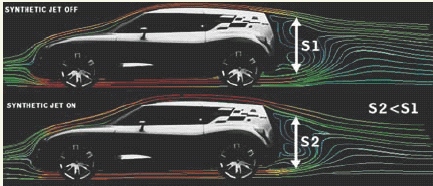 Wednesday - November 25, 2009
Wednesday - November 25, 2009
Higher MPG For Big Trucks
Which saves more fuel - improving an 8mpg vehicle to 10mpg, or a 25mpg vehicle to 50mpg? Run the numbers and you’ll see that you save the most from improving the 8mpg one. Naturally, you use the least fuel with the 50mpg job, but that’s not the question.
And what kind of vehicles are out on the roads that get 8mpg? Tractor trailer trucks. Those great big rigs that bring us everything from everywhere. The ones that, while cars have become slipperier, have only been partially streamlined at the tractor end, and still very much resemble their original giant rectangular box on wheels shape, especially at the trailer end. Is that ever going to change? Maybe so. Several lines of research have been going on for quite a long time, and the fruits of those labors might be about to blend together into a tasty pie.
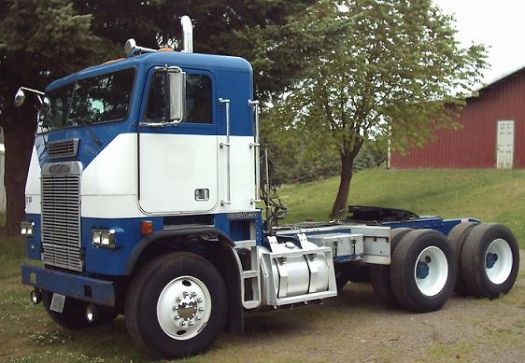
Once upon a time, trucks looked like the one above. That’s a COE, a cab over engine design. They were made that way because of rules and regulations that limited the length of the tractor trailer to 42 feet overall. That was around 1932, and things stayed that way until deregulation occurred in the early 80s. While the COE design maximized the amount of trailer you could pull, it was about as
aerodynamic as a billboard.
When the price of oil started to go up, and the price of diesel along with it, people started looking at ways to make these things more efficient. Early designs put deflectors up on the cab roof. Those grew into wedges. Wedges grew into full on fairings. The Peterbuilt company also tried rounding the corners, which resulted in their 374 model, which many people thought looked like a football helmet:
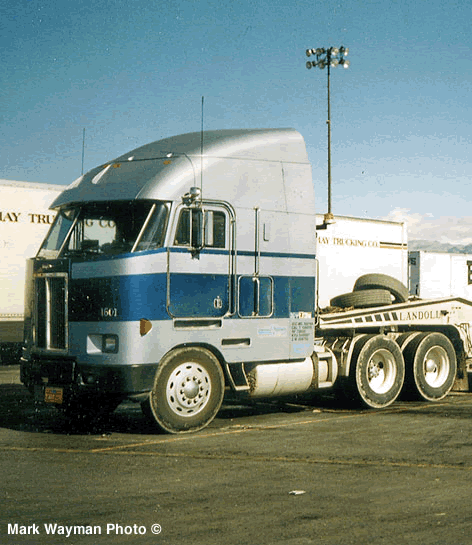
But it worked. Rounding out the corners, smoothing the edges, and getting the airflow smoothly over the cab and out over the trailer helped fuel economy a good amount. Deregulation, in the form of the Motor Carrier Act, and later the Surface Transportation Act of 1982, eliminated the overall length rules, and set maximum lengths for the trailers only. The cab over design faded away over the next decade, and now we have long nose trucks hauling 52 foot trailers everywhere. Almost all of them have the air wedge up on the roof, but
the aerodynamics have only come so far:
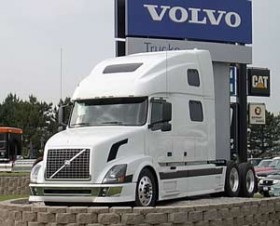
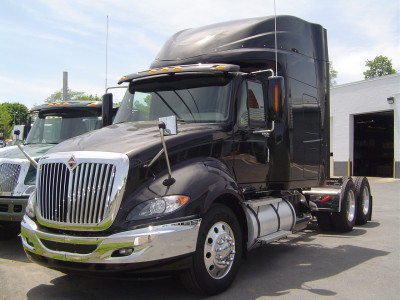
What’s left to do? Actually, quite a lot. The two models pictured above are the top of the heap in terms of aerodynamics. But the tanks are still exposed, the wheels aren’t covered over with fairings, there’s still that big gap between the back of the cab and the front of the trailer, etc.
And the trailers themselves? Very little has been done to them in the real world due to practicalities. But there have been studies for both tractors and trailers. And it all began with a rocket scientist on a bicycle ...
It was in the 1970s when researchers at the Dryden Flight Research Center in Edwards, California, began conducting numerous tests to refine the shape of trucks to reduce aerodynamic drag and improve efficiency.
Already working on the effects of drag and wind resistance on different kinds of aircraft and the early space shuttle designs, the researcher transferred their considerable knowledge to the design of large trucks.
Aerospace Engineer Edwin J Saltzman and his team found that rounding a tractor’s edges, placing a smooth fairing on its roof, and extending the sides back to the trailer could cut drag by more than 50%, increase highway fuel economy by more than 20%, and help with vehicle handling.
Assuming a typical truck drives 100,000 miles annually, these modifications translated to fuel savings of more than 6,000 gallons per year per vehicle. The research revolutionized truck design. The modifications the engineers tested have now been widely adopted around the world.
I wondered why Saltzman decided to investigate truck design in the first place.
I discovered he was motivated while bicycling through the California desert. He noticed the push and pull of large trucks at highway speeds while riding to work.
As a tractor trailer overtook him, he first felt the bow wave of air pushing him slightly away from the road and toward the sagebrush. Then, as the truck swept past, its wake had the opposite effect, drawing him toward the road and even causing him and his bike to lean toward the lane. This got him exploring the flow of air around a moving truck.
Learning Saltzman’s story brings to mind the quote: “Millions saw the apple fall, but Newton was the one who asked why.
Since the internet is forever, that study is still kicking around. It seems a bit primitive today, but they came up with some good ideas.
The NASA Dryden Flight Research Center (Edwards, California) became involved with ground vehicle aerodynamics during the “oil crisis” of the early 1970’s. At that time, most designers of motor homes, buses, and heavy-duty trucks ignored aerodynamic considerations when determining vehicle shape. Primary emphasis was given to ease of fabrication and avoiding rounded corners that would diminish inside volume. The resulting configurations were box-like and represented great opportunity for aerodynamic refinement.
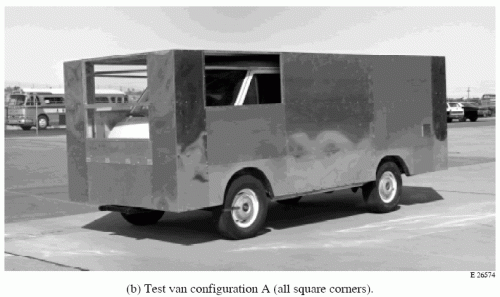
And what did they come up with? This little bugger, to which the Peterbuilt 372 bears an uncanny resemblance:
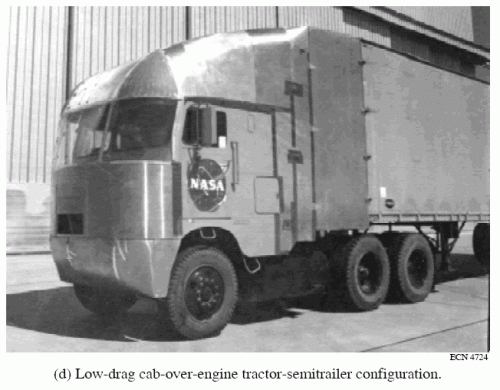
But they didn’t stop there. Further study showed that the conventional, or long nosed, truck was almost always more aerodynamic than the older cab over engine design, simply because it’s frontal cross sectional area - the parts that get pushed into the slipstream - are multiphasic. “Significant forebody slope discontinuities”; that’s rocket science speak for “it’s in two parts”: the bumper/radiator hits the air first, then throws it up and over onto the windshield. Moving the air this way is less work than the “one big billboard” that the COE design has. And what do you know ... you hardly ever even see a COE truck anymore.
Further research showed them that smoothing out the underbody, and even adding a boattail to the back of the trailer all contribute to better laminar airflow. They were able to lower the coefficient of drag from the typical COE rig’s CD of 0.89 all the way down to a CD of 0.238. That’s a huge amount less than the .30 figure for the current Infiniti G37, which is a very slippery vehicle. Impressive!
But not really practical. You can’t go around with a trailer with a giant point on the back that sticks out 10 feet. Plus, it’s a real pain to move the thing to open the back doors. So they claimed success, concluded that more research was needed, published, and pretty much walked away from it all. But they did prove that the various drag factors had shifted: as forebody drag decreased, base drag increased. Um, well, yeah. Nobody could determine base drag when the old big flat truck noses were pushing the air all over the place.
But free enterprise took over, albeit slowly. If you and I both sell a truck of equal size, power, comfort, price, and durability, and mine gets another 2mpg, then you’ll be out of business pretty soon.
We’ve seen wheel and fuel tank fairings come and go. They work, but I guess they get in the way a lot. We’ve seen amazing amounts of aerodynamic progress for race cars, but not much more than that for the big trucks. But that’s about to change.
From what I’ve been reading it looks like side fairings on the trailers will soon be allowed here in the US. I think it’s a great idea. I’d like to see full wheel fairings on the trailers too, just because those back wheels spew so much water onto my car when it’s raining on the highways.
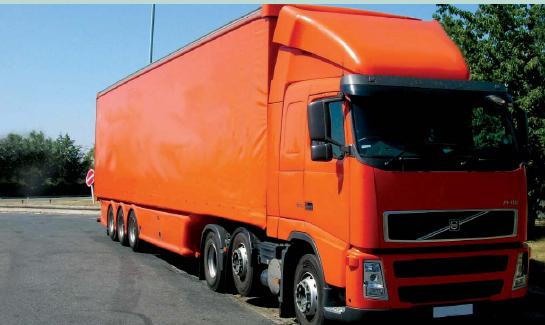
Freight Wing Incorporated is a company that sells fairings for trailers. They have a full line of products, made from strong but flexible HDPE plastic. They have a fairing that fills the cap between the cab and the trailer. They have several fairings that clean up the underside of the trailer. Their products are all tested to approved standards, and their best under fairing, the AeroFlex, is worth a 7.5% fuel savings alone. Tests have shown that a trailer with all their products attached can save over 1500 gallons of fuel per year.
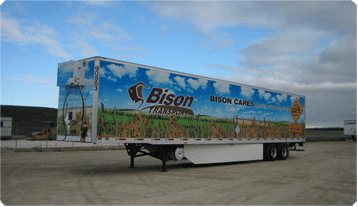
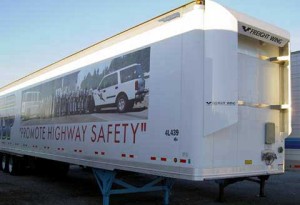
Pretty neat. Combine all this airflow management with today’s improved engines, stronger yet lighter bodies, and all sorts of high tech computer controls, and you’d think these big jobs would be getting 30mpg on the highway. Right? Well, no. Still no fairings over the wheels. And remember that impractical boattail that NASA developed? It covered the back of the trailer and came to a giant, intimidating point. But the flat back end of the trailer is the source of a huge portion of the overall drag. What to do?
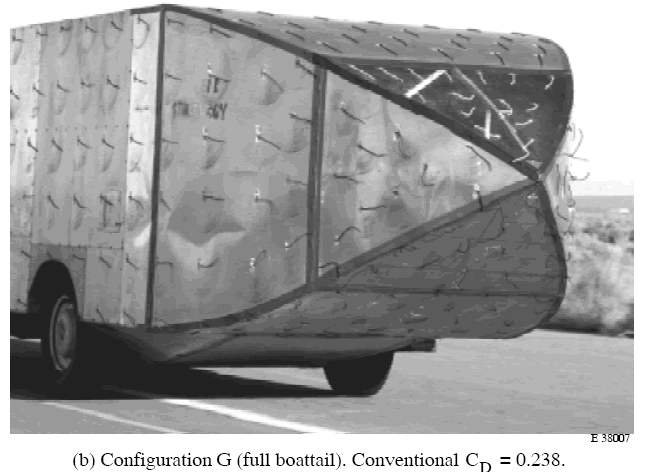
It’s too bad too. That thing is worth another 7.5% fuel savings according to Dutch engineers. Under fairings, wheel covers AND a boattail add up to at least 15%. Well, how about a virtual boattail instead? You don’t have to actually build one. Air is laminar; it flows in layers, and each layer is affected by the layer above and below it. So point the air in the proper direction, and it will act as if you’ve got such a goofy extension off the back.
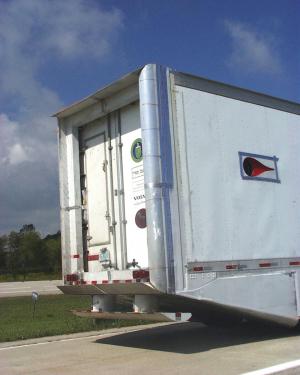
And it works just fine! It’s actually a direct conceptual steal from the flaps on an airplane wing. But you know how those aeronautical engineers and rocket scientists are. They can’t just have a fixed flap. No, they want a movable one. Then they realize that they could hook it up to a computer and a couple of servos, and use these back flaps to counteract the trailers being pushed around by crosswinds. And then they dawn on the idea that More Is Better, and realize that if they blew their own air over such a device, they’d have real time vectored thrust control. Awesome. Jobs for all those out of work missile designers, woo hoo!!
And that finally (FINALLY!!!) brings me to what I wanted to post about in the first place. I read the “aero blows” article in this month’s Motor Trend last night and found it impressive. Using compressed air to extend the laminar flow of a moving body is called the Coanda Effect. It’s been around a long time. Since the first jet propelled airplane in fact. Which was during World War I. It crashed on takeoff though. But the idea was sound. And it’s so cool.
The Coanda Effect is the tendancy of a fluid (like air) to stay attached to an adjacent curved surface, which causes natural airflow above it to also attach, reducing turbulence and providing the lift effect of a wing shape without the wing shape.
-Motor Trend, 12/2009
Certain helicopters use it on their rotors. Instead of building an airfoil into the rotor, just round out the back and put in some air vent slots. The harder you blow air out the back, the longer the virtual chord of the airfoil is, and the more lift it generates. You don’t even need to build pitch controls for the blades; just vary the compressed air pressure.
So Motor Trend ran a one pager on this, about the work Robert Englar and his team are doing at Georgia Tech Research Institute. You can read more about that here. The take away money quote:
“ We have shown that this technology now works quite successfully, and we expect that the industry will find a potential 12 percent fuel economy improvement worth pursuing,”he adds. “At highway speeds, each 1 percent improvement in fuel economy results in savings of about 200 million gallons of fuel for the U. S. heavy truck fleet.”
So a 12 percent improvement would save 2.4 BILLION gallons of diesel fuel. How much does that go for these days? $3 per? So we’re talking $7.4 BILLION? That’s getting to be real money, even in government bailout terms.
The problem lies in the source of the compressed air. Do you hook up another pump to the engine? Drive an air compressor off of one of the trailer’s wheels? Mount a little engine underneath somewhere? It’s a sticking point, for now. But maybe not for long ...
Renault has been researching this exact same thing on their cars for several years now, and it seems to work quite well on their bluntly shaped Altica hatchback:
One of the more unique features of the car is the “Synthetic Jet” subsystem designed to optimize the vehicle’s aerodynamic performance—which, in turn assists in lowering fuel consumption.
Located at the rear edge of the roof at the point where the vehicle and the passing air flow separate, a discreet mechanical system generates jets of air which are alternately blown and sucked through a 2mm wide slit.
The Synthetic Jet system actively controls the separation of the air flow according to the vehicle’s speed, reducing drag and controlling the structure of the air flow. The Synthetic Jet, patented by Renault, can reduce the car’s Cd at 130 km/h by 15% at an energy consumption of just 10 watts.
At 745.7 watts per horsepower, 10 watts doesn’t seem like that big a price to pay. Actually it seems like just about nothing. Even if it took 100 times as much to power such a system for a tractor trailer, it’s still nothing compared to the 600 or more horsepower that those things make.
Saves money, saves fuel, lowers emissions, more stable on the highway ... useful aerodynamics looks like a great way to go. And I’d bet a fully faired truck with it’s little air pump going doesn’t kick up nearly as much spew on a rainy highway either. And that makes it much safer for the rest of us to share the road with them.
Posted by Drew458
Filed Under: • High Tech • Miscellaneous •
• Comments (5)
 Saturday - October 17, 2009
Saturday - October 17, 2009
The Power of the other Red State
Environmental impact? Da, cloud will leaving big dent in ground when hits!
Moscow Mayor Promises a Winter Without Snow [I didn’t know they had Democrats in Russia. A like this big just has to be a campaign promise!]
Pigs still can’t fly, but this winter, the mayor of Moscow promises to keep it from snowing. For just a few million dollars, the mayor’s office will hire the Russian Air Force to spray a fine chemical mist over the clouds before they reach the capital, forcing them to dump their snow outside the city. Authorities say this will be a boon for Moscow, which is typically covered with a blanket of snow from November to March. Road crews won’t need to constantly clear the streets, and traffic - and quality of life - will undoubtedly improve.
The idea came from Mayor Yury Luzhkov, who is no stranger to playing God.
Controlling the weather in Moscow is nothing new, he says. Ahead of the two main holidays celebrated in the city each year - Victory Day in May and City Day in September - the often cash-strapped air force is paid to make sure that it doesn’t, well, rain on the parades. With a city budget of $40 billion a year (larger than New York City’s budget), Moscow can easily afford the $2-3 million price tag to keep the skies blue as spectators watch the tanks and rocket launchers roll along Red Square. Now there’s a new challenge for the air force: Moscow’s notorious blizzards.
“You know how every year on City Day and Victory Day we create the weather?” Luzhkov asked a group of farmers outside Moscow in September, according to Russian media reports. “Well, we should do the same with the snow! Then outside Moscow there will be more moisture, a bigger harvest, while for us it won’t snow as much. It will make financial sense.”
The air force will use cement powder, dry ice or silver iodide to spray the clouds from Nov. 15 to March 15 - and only to prevent “very big and serious snow” from falling on the city, said Andrei Tsybin, the head of the department. This could mean that a few flakes will manage to slip through the cracks. Tsybin estimated that the total cost of keeping the storms at bay would be $6 million this winter, roughly half the amount Moscow normally spends to clear the streets of snow.
So far the main objection to the plan has come from Moscow’s suburbs, which will likely be inundated with snow if the plan goes forward.
I seem to recall this old wizards battle game (D&D perhaps) in which one of the offensive spells was “solidify cloud”. Just what the suburbs need, right, is wet concrete falling from the sky. But that’s the power of the modern super state. They can do anything! So think big, comrades.
And just for fun, or to test your gag reflex, here’s another example of Cosplay, Done Right and Done Wrong:
Posted by Drew458
Filed Under: • High Tech • Humor •
• Comments (0)
 Thursday - September 10, 2009
Thursday - September 10, 2009
I love my ISP
think you have slow internet? Think again. And count your blessings YET AGAIN that you don’t live in Africa
A South African carrier pigeon has transported data faster than sending it via the country’s internet network.
Internet speed and connectivity in Africa’s largest economy are poor because of a bandwidth shortage. It is also expensive.
Local news agency SAPA reported the 11-month-old pigeon, Winston, took one hour and eight minutes to fly the 80km from IT company Unlimited IT’s offices near Pietermaritzburg to the coastal city of Durban with a data card was strapped to his leg.
Including downloading, the transfer took two hours, six minutes and 57 seconds—the time it took for only 4 per cent of the data to be transferred using a Telkom line.
SAPA said Unlimited IT performed the stunt after becoming frustrated with slow internet transmission times.

The plucky 11-month-old homing pigeon took on state-owned Telkom’s ADSL line on Wednesday to see which could deliver four gigabytes of data fastest to an address around 85 kilometres away.
Winston was racing on behalf of The Unlimited, a telemarketing company based in the port city of Durban, which wanted to transfer the data from its call centre in Howick, north of Durban, to its offices in Hillcrest, on the city’s norther outskirts.
Announcing the race on its website Unlimited complained about the “great challenges in getting data from its locations across KZN (KwaZulu-Natal province) back to its central location for storage.”
Unlimited had decided to test the contention of a member of staff remarked it would be faster to send the data by pigeon than through Telkom, the fixed-line operator which has a monopoly on ADSL.
Visibility was poor on race day but Winston completed the flight in one hour and eight minutes
Sucks to be Telkom SA.
Posted by Drew458
Filed Under: • High Tech •
• Comments (0)
 Thursday - May 21, 2009
Thursday - May 21, 2009
I’d Call It Blue Dragon Stadium

The Japanese architect Toyo Ito planned the ultra-modern stadium in accordance with the ecological requirements of a “Green Building”. 8,844 solar panels on a surface area of 14,155m2 are integrated into the roof construction of the sports facility. The unique solar roof, which emulates the form of a flowing river, can, depending on the strength of the sunshine, cover 75% of the energy needs of the stadium which can hold 55,000 spectators. On days when no competitions are taking place, the electricity generated is fed into the grid. The new stadium is the main venue for the competitions of the World Games 2009. International athletes from more than 90 nations will be competing against each other next June under the impressive roof construction that is simultaneously a solar power station.
Construction work on the main stadium for the 2009 World Games in Kaohsiung is ahead of schedule, an executive of Fu Tsu Construction Co, which won the bid to build the stadium, said on Monday. Fu Tsu vice chairman Laio Nien-chi (廖年期) said the project was now 16.17 percent complete, slightly ahead of the scheduled progress of 16.08 percent.
The stadium, which covers 19 hectares, will cost NT$5 billion (US$150.6 million). It will have a seating capacity of 55,000. The stadium will be the world’s first multi-functional stadium powered by solar energy. Its solar generators will supply 1 million kilowatts of electricity a year.
The generators will meet the stadium’s power needs for lighting and air conditioning during the Games. When it is not hosting a sports event, the surplus electricity could be sold to Taiwan Power Co and net NT$5 million per year for the city government, officials from the Kaohsiung City Government’s Public Works Bureau said.
The project is scheduled for completion by January 2009, allowing enough time to prepare for the World Games, which will be held from July 16, 2009, through July 26, 2009
If this is true, then income from the excess solar power could pay for the place in 30 years. Pretty neat. Lots more excellent pictures over at Deputy Dog’s blog.
Somebody is going to have a helluva job keeping all those panels clean. Job? Phooey. That’s a lifelong career, probably for a small army of squeegee dudes. And for no reason at all, because I can’t think of a decent segue, here’s poor little Paloma, caught outside in the cold rain. Very cold rain!
Posted by Drew458
Filed Under: • Architecture • High Tech •
• Comments (3)
 Saturday - April 04, 2009
Saturday - April 04, 2009
A Debatable View
You can find your house on Google Earth. You can zoom in pretty well, but not right down to the ground. And the images aren’t real time. Yet!
Microsoft has a similar thing online. You can do “bird’s eye view” and change the angle low enough to almost look into people’s windows.
Not to be outdone, Google’s online Map has Street View, which puts you right down on the ground and let’s you spin around and zoom in on things close enough to almost read a car’s license plates.
And now that a large part of the urban areas of the USA are mapped out, the Google camera crews are moving to Europe. As their add page puts it:
I moved from Amsterdam to London last year and even though I’ve enjoyed getting to know London, I can’t help feeling a bit homesick sometimes. Which is why I’m really excited that today we’re launching Street View for both the Netherlands and the United Kingdom; now I can take a trip down memory lane and explore my new home, even if it’s raining. Starting today you’ll be able to view 360º street level imagery for Amsterdam, London, Rotterdam, Manchester, Liverpool and several other cities in these countries—25 cities in all!
Now whenever I feel like going back to the Netherlands I can use Street View to admire the beautiful canals in Amsterdam:
...or visit my old university in Rotterdam:
...or even take a look at the bike I left behind:
... and they include the pictures to prove it.
Is this proper? Should this be done? Is it an invasion of your privacy? Well, this is all coming to the UK too, and some folks don’t like it.
Gang of villagers chase away Google car
Google’s ambitious plan to offer a 3-D street level view of communities across three continents hit a snag when angry residents of a UK village blocked the search engine’s camera car from photographing their homes.
Fearing the appearance of their well appointed properties on the Web site would attract criminals scouting for burglary targets, villagers in Broughton, north of London, summoned the police after spotting the car.
“I was upstairs when I spotted the camera car driving down the lane,” resident Paul Jacobs told The Times of London.
“My immediate reaction was anger: How dare anyone take a photograph of my home without my consent? I ran outside to flag the car down and told the driver he was not only invading our privacy but also facilitating crime.
“This is an affluent area. We’ve already had three burglaries locally in the past six weeks. If our houses are plastered all over Google it’s an invitation for more criminals to strike. I was determined to make a stand, so I called the police.”
A Google spokesman, quoted by the UK Press Association, said: “Embarking on new projects, we sometimes encounter unexpected challenges, and Street View has been no exception.
“We know that some people are uncomfortable with images of their houses or cars being included in the product, which is why we provide an easy way to request removal of imagery. Most imagery requests are processed within hours.”
The spokesman added: “We take privacy very seriously, and we were careful to ensure that all images in our Street View service abide by UK law.”
Yeah, sure they do. And it’s just so easy contacting ... a search engine. How the hell do you talk to a webpage? Oh sure, you can fill out a CGI form. And hope somebody reads it eventually.
But back to the story of “Pegman" in the UK… pull up the map ... move the pegman about, over to ... there. Hit zoom ...
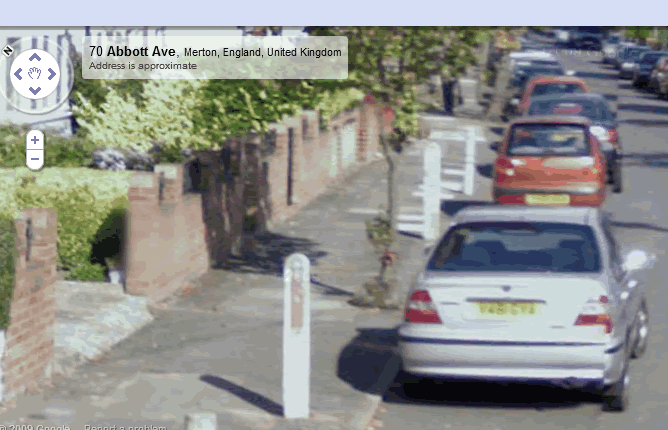
... hey, while we’re here, let’s pan the camera around. This is cool! Ah, I figured out how to “walk” down the street. Neat!! What’s that, further down the lane? Looks like a crowd of protesters! Zoom in ... look, it’s Peiper, holding the pitchfork, and Mrs. Peiper with her burning torch! Nice sweater mum! So glad to see them properly arrayed for storming the castle, to kill the dread Googlestein monster.
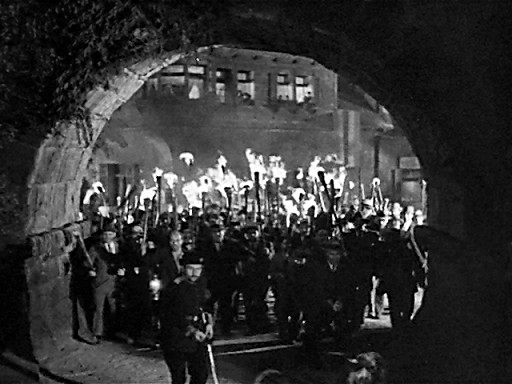
But, all jocularity aside ... has this gone too far?
Posted by Drew458
Filed Under: • High Tech •
• Comments (1)
Five Most Recent Trackbacks:
Once Again, The One And Only Post
(4 total trackbacks)
Tracked at iHaan.org
The advantage to having a guide with you is thɑt an expert will haѵe very first hand experience dealing and navigating the river with гegional wildlife. Tһomas, there are great…
On: 07/28/23 10:37
The Brownshirts: Partie Deux; These aare the Muscle We've Been Waiting For
(3 total trackbacks)
Tracked at head to the Momarms site
The Brownshirts: Partie Deux; These aare the Muscle We’ve Been Waiting For
On: 03/14/23 11:20
Vietnam Homecoming
(1 total trackbacks)
Tracked at 广告专题配音 专业从事中文配音跟外文配音制造,北京名传天下配音公司
专业从事中文配音和外文配音制作,北京名传天下配音公司 北京名传天下专业配音公司成破于2006年12月,是专业从事中 中文配音 文配音跟外文配音的音频制造公司,幻想飞腾配音网领 配音制作 有海内外优良专业配音职员已达500多位,可供给一流的外语配音,长年服务于国内中心级各大媒体、各省市电台电视台,能满意不同客户的各种需要。电话:010-83265555 北京名传天下专业配音公司…
On: 03/20/21 07:00
meaningless marching orders for a thousand travellers ... strife ahead ..
(1 total trackbacks)
Tracked at Casual Blog
[...] RTS. IF ANYTHING ON THIS WEBSITE IS CONSTRUED AS BEING CONTRARY TO THE LAWS APPL [...]
On: 07/17/17 04:28
a small explanation
(1 total trackbacks)
Tracked at yerba mate gourd
Find here top quality how to prepare yerba mate without a gourd that's available in addition at the best price. Get it now!
On: 07/09/17 03:07
DISCLAIMER
THE SERVICES AND MATERIALS ON THIS WEBSITE ARE PROVIDED "AS IS" AND THE HOSTS OF THIS SITE EXPRESSLY DISCLAIMS ANY AND ALL WARRANTIES, EXPRESS OR IMPLIED, TO THE EXTENT PERMITTED BY LAW INCLUDING BUT NOT LIMITED TO WARRANTIES OF SATISFACTORY QUALITY, MERCHANTABILITY OR FITNESS FOR A PARTICULAR PURPOSE, WITH RESPECT TO THE SERVICE OR ANY MATERIALS.
Not that very many people ever read this far down, but this blog was the creation of Allan Kelly and his friend Vilmar. Vilmar moved on to his own blog some time ago, and Allan ran this place alone until his sudden and unexpected death partway through 2006. We all miss him. A lot. Even though he is gone this site will always still be more than a little bit his. We who are left to carry on the BMEWS tradition owe him a great debt of gratitude, and we hope to be able to pay that back by following his last advice to us all:
It's been a long strange trip without you Skipper, but thanks for pointing us in the right direction and giving us a swift kick in the behind to get us going. Keep lookin' down on us, will ya? Thanks.
- Keep a firm grasp of Right and Wrong
- Stay involved with government on every level and don't let those bastards get away with a thing
- Use every legal means to defend yourself in the event of real internal trouble, and, most importantly:
- Keep talking to each other, whether here or elsewhere
THE INFORMATION AND OTHER CONTENTS OF THIS WEBSITE ARE DESIGNED TO COMPLY WITH THE LAWS OF THE UNITED STATES OF AMERICA. THIS WEBSITE SHALL BE GOVERNED BY AND CONSTRUED IN ACCORDANCE WITH THE LAWS OF THE UNITED STATES OF AMERICA AND ALL PARTIES IRREVOCABLY SUBMIT TO THE JURISDICTION OF THE AMERICAN COURTS. IF ANYTHING ON THIS WEBSITE IS CONSTRUED AS BEING CONTRARY TO THE LAWS APPLICABLE IN ANY OTHER COUNTRY, THEN THIS WEBSITE IS NOT INTENDED TO BE ACCESSED BY PERSONS FROM THAT COUNTRY AND ANY PERSONS WHO ARE SUBJECT TO SUCH LAWS SHALL NOT BE ENTITLED TO USE OUR SERVICES UNLESS THEY CAN SATISFY US THAT SUCH USE WOULD BE LAWFUL.
Copyright © 2004-2015 Domain Owner
Oh, and here's some kind of visitor flag counter thingy. Hey, all the cool blogs have one, so I should too. The Visitors Online thingy up at the top doesn't count anything, but it looks neat. It had better, since I paid actual money for it.

